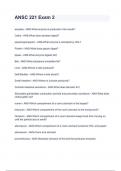Ansc 221 exam 2 4 Study guides, Class notes & Summaries
Looking for the best study guides, study notes and summaries about Ansc 221 exam 2 4? On this page you'll find 18 study documents about Ansc 221 exam 2 4.
All 18 results
Sort by
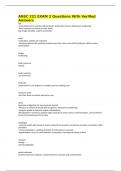
-
ANSC 221 EXAM 2 Questions With Verified Answers
- Exam (elaborations) • 17 pages • 2024
-
- $11.09
- + learn more
ANSC 221 EXAM 2 Questions With Verified Answers lips -most important for animals without hands, prehension (horse), sifting food, swallowing; -least important to chicken (no lips, beak) lips of pigs immobile, used for protection teeth mastication, particle size reduction -chewing important for ruminant animals-more they chew, more HCO3 produced, affects rumen fermentation tongue swallowing teeth carnivore tearing teeth omnivore can chew food teeth pig cheek tee...
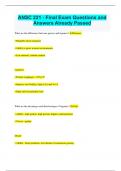
-
ANSC 221 - Final Exam Questions and Answers Already Passed
- Exam (elaborations) • 16 pages • 2024
- Available in package deal
-
- $9.99
- + learn more
ANSC 221 - Final Exam Questions and Answers Already Passed What are the differences between grasses and legumes? Grasses: • Palatable when immature • Ability to grow in most environments • Low mineral, vitamin content Legumes: • Protein roughages > 10% CP • Improve soil fertility, high in Ca and Vit A • High yield of palatable feed What are the advantages and disadvantages of legumes? Adv • Alfalfa - high quality, high protein, highest yield potential • Clo...
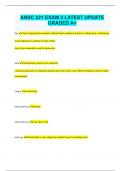
-
ANSC 221 EXAM 2 LATEST UPDATE GRADED A+
- Exam (elaborations) • 36 pages • 2024
- Available in package deal
-
- $10.99
- + learn more
ANSC 221 EXAM 2 LATEST UPDATE GRADED A+ lips -most important for animals without hands, prehension (horse), sifting food, swallowing; -least important to chicken (no lips, beak) lips of pigs immobile, used for protection teeth mastication, particle size reduction -chewing important for ruminant animals-more they chew, more HCO3 produced, affects rumen fermentation tongue swallowing teeth carnivore tearing teeth omnivore can chew food teeth pig cheek teeth w cone shaped o...
ANSC 221 Exam 2 (4)
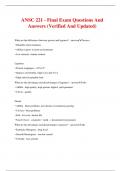
-
ANSC 221 - Final Exam Questions And Answers (Verified And Updated)
- Exam (elaborations) • 8 pages • 2024
- Available in package deal
-
- $11.49
- + learn more
ANSC 221 - Final Exam Questions And Answers (Verified And Updated) What are the differences between grasses and legumes? - answerGrasses: • Palatable when immature • Ability to grow in most environments • Low mineral, vitamin content Legumes: • Protein roughages > 10% CP • Improve soil fertility, high in Ca and Vit A • High yield of palatable feed What are the advantages and disadvantages of legumes? - answerAdv • Alfalfa - high quality, high protein, highest yield po...
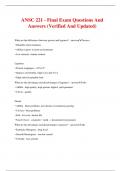
-
ANSC 221 - Final Exam Questions And Answers (Verified And Updated)
- Exam (elaborations) • 8 pages • 2024
- Available in package deal
-
- $11.49
- + learn more
ANSC 221 - Final Exam Questions And Answers (Verified And Updated) What are the differences between grasses and legumes? - answerGrasses: • Palatable when immature • Ability to grow in most environments • Low mineral, vitamin content Legumes: • Protein roughages > 10% CP • Improve soil fertility, high in Ca and Vit A • High yield of palatable feed What are the advantages and disadvantages of legumes? - answerAdv • Alfalfa - high quality, high protein, highest yield po...
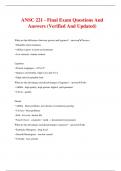
-
ANSC 221 - Final Exam Questions And Answers (Verified And Updated)
- Exam (elaborations) • 8 pages • 2024
- Available in package deal
-
- $11.49
- + learn more
ANSC 221 - Final Exam Questions And Answers (Verified And Updated) What are the differences between grasses and legumes? - answerGrasses: • Palatable when immature • Ability to grow in most environments • Low mineral, vitamin content Legumes: • Protein roughages > 10% CP • Improve soil fertility, high in Ca and Vit A • High yield of palatable feed What are the advantages and disadvantages of legumes? - answerAdv • Alfalfa - high quality, high protein, highest yield po...
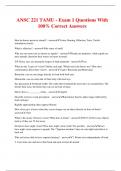
-
ANSC 221 TAMU - Exam 1 Questions With 100% Correct Answers
- Exam (elaborations) • 24 pages • 2024
-
- $14.49
- + learn more
ANSC 221 TAMU - Exam 1 Questions With 100% Correct Answers How do horses perceive stimuli? - answerVision, Hearing, Olfaction, Taste, Tactile stimulation (touch) What is olfaction? - answerthe sense of smell Why are our senses not as intense as equids? - answerPeople are predators, while equids are prey animals, therefore their senses are more in tuned. T/F: Horse eyes are among the largest of land mammals - answerTrue What are the 2 types of vision? Define each type. Which one(s) do hor...
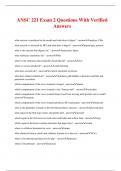
-
ANSC 221 Exam 2 Questions With Verified Answers
- Exam (elaborations) • 7 pages • 2024
- Available in package deal
-
- $11.49
- + learn more
ANSC 221 Exam 2 Questions With Verified Answers what enzyme is produced in the mouth and what does it digest? - answeramylase, CHo what enzyme is activated by HCl and what does it digest? - answerpepsinogen, protein what is the enzyme that digests fat? - answerpancreatic lipase what substance emulsifies fat? - answerbile where is the substance that emulsifies fat produced? - answerliver where is sucrase produced? - answersmall intestine what does secretin do? - answercontrols intestinal ...
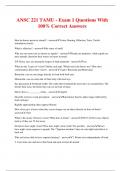
-
ANSC 221 TAMU - Exam 1 Questions With 100% Correct Answers
- Exam (elaborations) • 24 pages • 2024
- Available in package deal
-
- $13.49
- + learn more
ANSC 221 TAMU - Exam 1 Questions With 100% Correct Answers How do horses perceive stimuli? - answerVision, Hearing, Olfaction, Taste, Tactile stimulation (touch) What is olfaction? - answerthe sense of smell Why are our senses not as intense as equids? - answerPeople are predators, while equids are prey animals, therefore their senses are more in tuned. T/F: Horse eyes are among the largest of land mammals - answerTrue What are the 2 types of vision? Define each type. Which one(s) do hor...

How did he do that? By selling his study resources on Stuvia. Try it yourself! Discover all about earning on Stuvia

